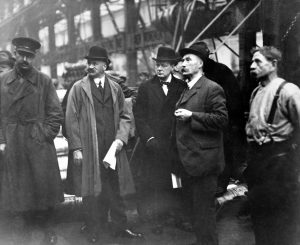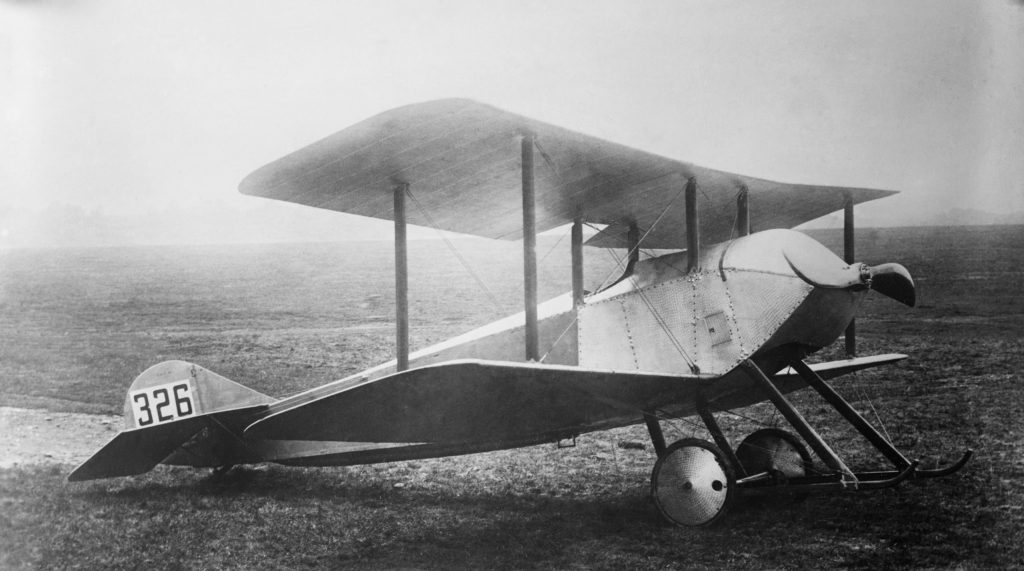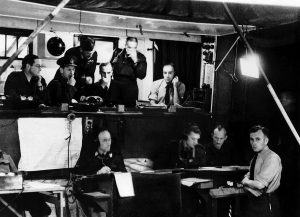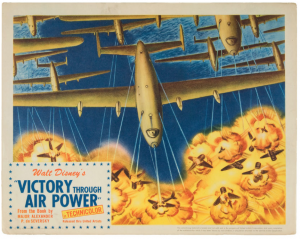
Finest Hour 185
The Sopwith Churchill

The Sopwith Tabloid, upon which Churchill‘s model was based, pictured in 1915
December 22, 2019
Finest Hour 185, Third Quarter 2019
Page 10
By Fred Glueckstein
Fred Glueckstein is a regular contributor to Finest Hour and author of Churchill and Colonist II (2015).
October 1913
On the 29th Mr. Winston Churchill, flying with the late Captain Lushington, R.M.A., took control of the aeroplane himself during the greater part of an hour’s flight, thus becoming the first Cabinet Minister of any nation to pilot an aeroplane.1
The most successful British fighter of the First World War, the Camel was built by the Sopwith Aviation Company. The highly maneuverable Sopwith Camel was a biplane, a fixed-wing aircraft with two main wings stacked one above the other. It proved far superior to all German types of dogfighters until the introduction of the Fokker D. VII in 1918. Altogether, Sopwith built 5,490 Camels. The plane’s top speed was 118 miles (189 kilometers) per hour, and it had a ceiling of 24,000 feet (7,300 meters). The Camel was credited with 1,294 enemy aircraft destructions.
During the First World War, Sopwith designed and built other fighters, including the Tabloid. Originally a two-seat plane, single-seat variants of the Tabloid went into production in 1914, and thirty-six fighters eventually entered service with the Royal Flying Corps (RFC) and the Royal Naval Air Service (RNAS). In addition to being a fighter, the Tabloid was also used as a bomber and was the first to bomb German air sheds in Cologne and Dusseldorf in October 1914.

2025 International Churchill Conference
Sopwith Sociable
The RNAS was the air arm of the Royal Navy, under the direction of the Admiralty’s Air Department. It existed formally from 1 July 1914 to 1 April 1918, when it was merged with the British Army’s RFC to form a new service, the Royal Air Force (RAF). The minister responsible for overseeing the creation of the RNAS was First Lord of the Admiralty Winston Churchill.
In late 1913, Churchill’s eye was caught by a scaledup version of the Tabloid known as the “Sopwith Sociable” because the two-man crew was seated side-by-side rather than in tandem. The Sociable was a British single-engine, two-seat tractor (engine mounted with a two- blade propeller in front) biplane. It was powered by a (75 kW) Gnome Monosoupape, a 100 hp nine-cylinder air-cooled rotary engine.
Churchill liked the design of the Sociable because the aircraft would permit the First Lord to inspect the fleet from the air. He therefore requested that the RNAS place an order for the Sociable and in December 1913 dictated the general specifications.
Sopwith Aviation began work on the Sociable on 24 December. Among the Admiralty’s requirements outlined in the contract were that the accommodation should be “roomy” and the seats especially upholstered in leather, widely reported to have been specified by Churchill for his own comfort. Specifications by the Admiralty also included “4 hours [flight] duration, and starting from pilot’s seat—safety belts, shoulder straps, adjustable windshield, dashboard clock, map case—and spare tank to fit in passenger’s seat.”2
During the week of 9 February 1914, Churchill visited Sopwith Aviation. The First Lord of the Admiralty was in the habit of making such inspections in order to familiarize himself with the Royal Navy’s suppliers. He toured the Kingston factory in Brooklands and no doubt wanted to see that “his” Sopwith Sociable was nearing completion.
Churchill’s Sociable was given serial number 149 by the Admiralty, and on 16 February 1914 it was first flown at Brooklands by test pilot Howard Pixton. Three days later, the biplane was handed over by Pixton to Lt. Spencer Grey, who accepted it on behalf of the Admiralty. Grey was determined to get the Sopwith Sociable to Hendon promptly because the next day he was scheduled to take Churchill on a flight in the brand new aircraft.
Grey was hindered by rain and mist, however, and it took two-and-a-half hours to cover the nineteen miles from Brooklands to Hendon. During the trip, Grey had to fly a good deal out of his way and descended four times to stop and ask directions.
The Sopwith Churchill
With Lt. Grey at the controls on 20 February, Churchill flew in the Sopwith Sociable as a passenger. Unfortunately, a strong wind was blowing, and the Sociable only attained 600 feet. Grey piloted the Sopwith Sociable on several occasions with Churchill aboard, and the biplane gained the nickname the “Sopwith Churchill.”
On 4 March, Churchill was guest of honor at the Royal Aero Club Annual Dinner, and he was warmly welcomed for his active role in advancing naval aviation. There were seventy-one pilots present, including almost every wellknown name in British military and civil aviation.
The Sopwith Sociable was praised in The Aeroplane: “Its speed is 80 to 85 mph and it is intended mainly for shore patrols from Naval Air Stations. It is an excellent piece of work throughout.”3 Churchill, who was learning to fly a plane himself, would have agreed that the Sopwith Sociable was an impressive British-built machine.
The biplane’s future, however, was short-lived. While based at Eastchurch in Kent, the Sopwith Churchill spun into the ground on take-off on 25 March. It was repaired by Sopwith Aviation and delivered to No. 3 Squadron RNAS in Belgium in September, one month after the First World War had started. The aircraft was fitted with an additional fuel tank and a bomb rack. Subsequently, the biplane was used on an abortive attempt to bomb a German airship shed at Cologne on 22 September.
Final Flight
T he Sopwith Churchill was then transferred to No. I Squadron RNAS, but broke an axle on take-off from Antwerp, damaging the landing gear and the upper wing. While awaiting repair at Antwerp, the Sopwith Churchill was abandoned following the advance of German troops. It was deleted from Admiralty Lists on 14 October 1914.
Although the only one built during the First World War, the Sopwith Churchill is an interesting historical note in the annals of British military aircraft design and manufacture. It is also an example of Winston Churchill’s keen interest as First Lord of the Admiralty in military aviation for the Royal Navy.
Churchill’s interest in military aviation during the First World War continued after the conflict as he followed with great concern England’s failure to maintain corresponding air power with Nazi Germany in the years leading to the Second World War. When it came to air power, Winston Churchill both literally and figuratively was always looking out for Britain.
Endnotes
1. “Churchill an Aviator: British Minister Guides a Biplane for Forty-five Minutes,” New York Times, 2 December 1913, p. 1.
2. “Review of the Past Year,” The Aeroplane, 1 January 1914, p. 10.
3. Ibid., 16 February 1914.
Subscribe
WANT MORE?
Get the Churchill Bulletin delivered to your inbox once a month.





